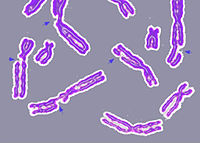
Photo from wikipedia
Abstract Internal microcracks that occur in cement-based materials during the service process could be self-repaired using microcapsules. However, the chemical activity of the repairing agent is affected by the external… Click to show full abstract
Abstract Internal microcracks that occur in cement-based materials during the service process could be self-repaired using microcapsules. However, the chemical activity of the repairing agent is affected by the external environment. In this paper, the self-repairing ability of mortar containing paraffin/toluene-di-isocyanate (TDI) microcapsules was studied under different external environment (humidity and temperature). The pore size distribution, mechanical properties, impermeability and surface crack width of the control mortar (CM) and mortar containing microcapsules (MM) were measured and compared. The reaction kinetics of TDI during the self-repairing process of MM was investigated using pseudo-first-order and pseudo-second-order kinetics models. The self-repairing ability of MM was enhanced when increasing RH (relative humidity) from 50% to 95% at 20 ℃. When MM was kept under 60%fc0 pre-load and allowed 7 d for self-repairing at a relative humidity of 95%, the proportion of harmful pores, compressive strength reserved ratio and chloride diffusion coefficient recovery ratio were 28.1%, 80.9% and 68.1%, respectively, and cracks with an initial width of 0.4–0.5 mm self-repaired within 6 h. With the increasing of temperatures, the self-repairing ability increased at first but then declined. When the temperature was 50 ℃ at 50% RH, the proportion of harmful pores, compressive strength reserved ratio and chloride diffusion coefficient recovery ratio of MM under 60%fc0 pre-load for 7 d of self-repairing were 25.8%, 83.5% and 72.1%, respectively, and cracks with an initial width of 0.4–0.5 mm self-repaired within 5 h. Under different external environment and pre-loads, the curing reaction of TDI during the self-repairing process of MM was a pseudo-second-order kinetics model, which indicated that the humidity and temperature had a significant impact on the self-repairing ability of the mortar.
Journal Title: Construction and Building Materials
Year Published: 2021
Link to full text (if available)
Share on Social Media: Sign Up to like & get
recommendations!